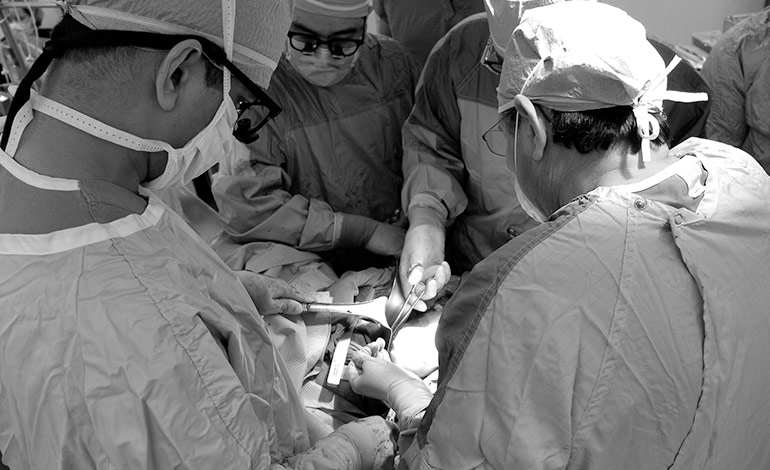Aortic Surgery
 The aorta is the main vessel of the human body providing blood to all organs. Starting at the root of the heart, attached to the aortic valve, branches to heart, brain, arms, spinal cord, visceral organs (intestines, liver, stomach), kidneys, and legs originate from the aorta. An aortic aneurysm is a “ballooning” in this main blood vessel that can lead to rupture or dissection. Aortic dissection occurs when the middle layer of the aortic wall splits creating a “false” channel for blood flow. This dissecting process weakens the aortic wall making it more prone to rupture. When rupture occurs, survival is often less than 10%. Aortic dissection can also lead to obstruction of any of the branches of the aorta and ultimate organ death. Although many risk factors for aortic aneurysms have been identified, the exact cause remains unknown.
The aorta is the main vessel of the human body providing blood to all organs. Starting at the root of the heart, attached to the aortic valve, branches to heart, brain, arms, spinal cord, visceral organs (intestines, liver, stomach), kidneys, and legs originate from the aorta. An aortic aneurysm is a “ballooning” in this main blood vessel that can lead to rupture or dissection. Aortic dissection occurs when the middle layer of the aortic wall splits creating a “false” channel for blood flow. This dissecting process weakens the aortic wall making it more prone to rupture. When rupture occurs, survival is often less than 10%. Aortic dissection can also lead to obstruction of any of the branches of the aorta and ultimate organ death. Although many risk factors for aortic aneurysms have been identified, the exact cause remains unknown.
Although most aortic aneurysms occur in the infrarenal abdominal aorta (the segment of the aorta below the renal arteries in the abdomen), many do occur above this area. Aortic aneurysms can be classified by anatomical location. The ascending aorta is located near the heart at the front of the chest giving branches to the heart (coronary arteries). This is the area most commonly affected by aortic dissection. The late actor John Ritter was afflicted with this disorder. The ascending aorta leads to the transverse aortic arch giving branches to the brain (innominate, and left common carotid arteries) and the arms (subclavian arteries). The transverse arch also directs blood to the back of the chest leading to the descending thoracic aorta. This segment of aorta no travels downward towards the abdomen giving branches to the spinal cord (intercostals arteries). Crossing through the chest, through the diaphragm, the aorta enters the abdomen. In the abdomen, the aorta gives off branches to the liver, stomach, spleen (celiac axis), the small intestines (superior and inferior mesenteric arteries), and kidneys (renal arteries). The infrarenal abdominal aorta then branches in the pelvis into the iliac arteries.
Surgeons of the department have been leaders in the field of aortic surgery for 3 decades developing and perfecting all aspects of aortic disease management. Procedures involve clinical investigation with the goal of optimizing techniques of repairs of the ascending, transverse, arch and thoracoabdominal aorta. Refinement in techniques are being investigated to provide multiorgan protection. This will include cerebral and spinal cord, renal, visceral, pulmonary and cardiac protection, to prevent strokes, kidney failure, paralysis or heart attacks.
A section of Aortic Surgery, is actively involved in treatment, research, and education of all aspects of aortic disease. A referral for connective tissue disorders (Marfan’s disease) has been established in conjunction with genetics researchers. Collaboration with the University of Texas at Houston Department of Internal Medicine, division of medical genetics has culminated being awarded the National Institutes of Medicine-National Heart, Lung, and Blood Institute (NHLBI) Specialized Center for Clinically Oriented Research for thoracic aortic aneurysms and dissection grant (SCCOR) for $ 13 million.
In addition, minimizing the stress exposed to the patient with minimally invasive approaches will also be pursued. This includes the use of robotic technology to use “key hole” incisions for these extensive repairs and also endovascular techniques.
The Division and its faculty provide preoperative, operative, and critical care for all diseases of the aorta including:
- Aortic root aneurysms
- Ascending aortic aneurysms
- Transverse aortic arch aneurysms
- Descending thoracic aortic aneurysms
- Thoracoabdominal aortic aneurysms
- abdominal aortic aneurysms
- acute and chronic aortic dissections
- Atheromatous disease of the aorta
- Coarctation
- Marfan’s syndrome
- Familial thoracic aortic aneurysms and dissections
- Ehler-Danlos syndrome
- Bicuspid aortic valve
The faculty are leaders in innovation for aortic surgery performing procedures including:
- Complex valve sparing aortic replacement procedures
- Hybrid arch and thoracoabdominal aortic aneurysm repair
- Percutaneous interventions for aortic dissection
- Thoracic endovascular aortic repair (TEVAR)
- Endovascular repair of throacoabdominal aortic aneurysms
Additional Patient Resources to learn more: